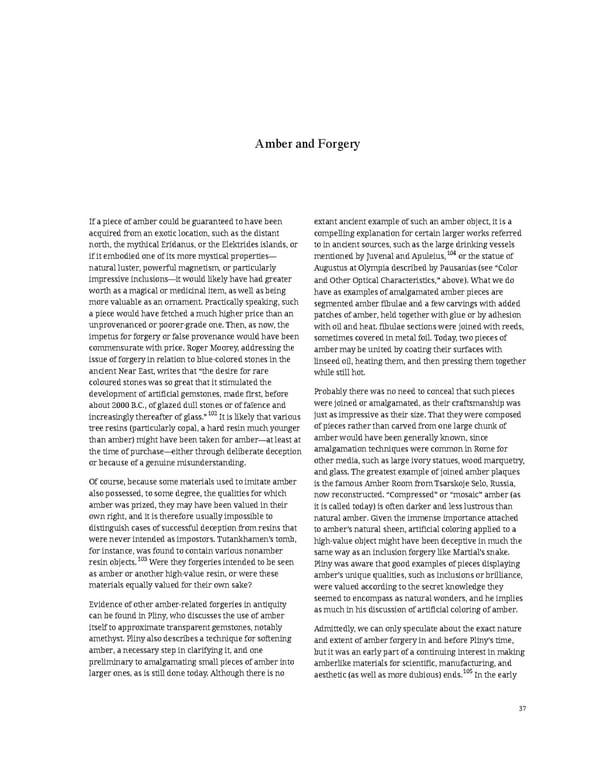Amber and Forgery If a piece of amber could be guaranteed to have been extant ancient example of such an amber object, it is a acquired from an exotic location, such as the distant compelling explanation for certain larger works referred north, the mythical Eridanus, or the Elektrides islands, or to in ancient sources, such as the large drinking vessels if it embodied one of its more mystical properties— mentioned by Juvenal and Apuleius,104 or the statue of natural luster, powerful magnetism, or particularly Augustus at Olympia described by Pausanias (see “Color impressive inclusions—it would likely have had greater and Other Optical Characteristics,” above). What we do worth as a magical or medicinal item, as well as being have as examples of amalgamated amber pieces are more valuable as an ornament. Practically speaking, such segmented amber fibulae and a few carvings with added a piece would have fetched a much higher price than an patches of amber, held together with glue or by adhesion unprovenanced or poorer-grade one. Then, as now, the with oil and heat. fibulae sections were joined with reeds, impetus for forgery or false provenance would have been sometimes covered in metal foil. Today, two pieces of commensurate with price. Roger Moorey, addressing the amber may be united by coating their surfaces with issue of forgery in relation to blue-colored stones in the linseed oil, heating them, and then pressing them together ancient Near East, writes that “the desire for rare while still hot. coloured stones was so great that it stimulated the development of artificial gemstones, made first, before Probably there was no need to conceal that such pieces about 2000 B.C., of glazed dull stones or of faïence and were joined or amalgamated, as their craftsmanship was increasingly thereafter of glass.”102 It is likely that various just as impressive as their size. That they were composed tree resins (particularly copal, a hard resin much younger of pieces rather than carved from one large chunk of than amber) might have been taken for amber—at least at amber would have been generally known, since the time of purchase—either through deliberate deception amalgamation techniques were common in Rome for or because of a genuine misunderstanding. other media, such as large ivory statues, wood marquetry, and glass. The greatest example of joined amber plaques Of course, because some materials used to imitate amber is the famous Amber Room from Tsarskoje Selo, Russia, also possessed, to some degree, the qualities for which now reconstructed. “Compressed” or “mosaic” amber (as amber was prized, they may have been valued in their it is called today) is often darker and less lustrous than own right, and it is therefore usually impossible to natural amber. Given the immense importance attached distinguish cases of successful deception from resins that to amber’s natural sheen, artificial coloring applied to a were never intended as impostors. Tutankhamen’s tomb, high-value object might have been deceptive in much the for instance, was found to contain various nonamber same way as an inclusion forgery like Martial’s snake. resin objects.103 Were they forgeries intended to be seen Pliny was aware that good examples of pieces displaying as amber or another high-value resin, or were these amber’s unique qualities, such as inclusions or brilliance, materials equally valued for their own sake? were valued according to the secret knowledge they Evidence of other amber-related forgeries in antiquity seemed to encompass as natural wonders, and he implies can be found in Pliny, who discusses the use of amber as much in his discussion of artificial coloring of amber. itself to approximate transparent gemstones, notably Admittedly, we can only speculate about the exact nature amethyst. Pliny also describes a technique for softening and extent of amber forgery in and before Pliny’s time, amber, a necessary step in clarifying it, and one but it was an early part of a continuing interest in making preliminary to amalgamating small pieces of amber into amberlike materials for scientific, manufacturing, and larger ones, as is still done today. Although there is no aesthetic (as well as more dubious) ends.105 In the early 37
 Ancient Carved Ambers in the J. Paul Getty Museum Page 46 Page 48
Ancient Carved Ambers in the J. Paul Getty Museum Page 46 Page 48